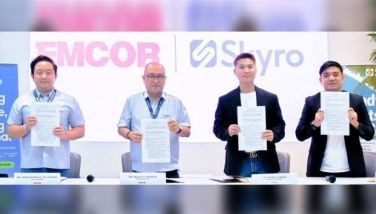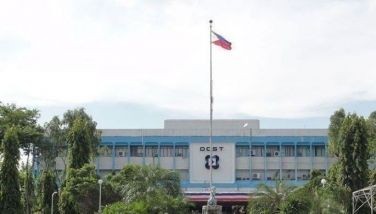Midnite shopping for new water sources?

While the current drought has not yet critically affected Metro Manila’s water supply, the writing on the wall is clear. Angat River, which is essentially the only source of drinking water for the metropolis, will no longer be able to adequately supply more than 15 million Filipino’s needs five years from now.
That said, the two private water concessionaires of the government’s Metropolitan Waterworks and Sewerage System supplying water to Metro Manila are already looking for possible new sources, including from the proposed controversial $1-billion Laiban Dam project.
Bearing in mind that dams take years to construct and in view of time limitations, there is pressure to accept the Laiban project without the required due diligence and requisite studies, and to accept as gospel truth whatever the favored lead project proponent has prepared.
Acceptable attributes
In reality, establishing Metro Manila’s new water source for the next 50 years requires a lot of work. Any new water source must have proven supply through sufficient studies over 30 to 50 years taken during various weather cycles.
It must also demonstrate levels that can address the requirements for growth. Ideally, it should be developed in stages to match demand, thus maximizing on the huge capital expenditures and avoiding wasted capacity.
The project should also be sensitive to social and environmental issues since the flooding of huge and significant areas is often unavoidable. All of these are necessary to avoid the delays arising from possible protests, and to pave the way for financing.
Business wise, these new sources must be cost competitive, with reasonable capital costs per unit capacity, and low treatment and operating costs, to avoid large jumps in tariffs, which will encourage revival of losses from unaccounted for water, and force more subsidy for low income groups.
Let’s review some other supply options open to MWSS concessionaires aside from Laiban.
Wawa
Even before Angat Dam was built, there was the Wawa Dam capable of supplying 50 million liters per day of Manila’s needs. This facility has not entirely outlived its purpose although it has limited development options relative to the construction of a water treatment plant.
However, Wawa still has value especially during the rainy season when it has ample supply. Should this source be considered to augment Metro Manila’s needs, the only deterrent to its re-operation would be the resolution of claims by various parties over water supplies and facilities.
Pampanga River
The Pampanga River is another source that may be considered. As the second largest river system in the country next to Cagayan River, its upper portions have been used for the Magat and Pantabangan dams.
The lower portions, however, near Calumpit, Bulacan, which eventually exit to Manila Bay via Lanbangan Channel, are proposed to be harnessed for domestic use by Bulacan. This river has similar issues with drought and low levels during summer, and contamination from agricultural chemicals and garbage. In addition, its lower reaches have saline contamination during the summer months when salt water Manila Bay intrudes up the river.
Bulacan towns neighboring Metro Manila are generally supplied by ground water through wells. With the continued increase in population, there is need to supplement the supply from Angat Dam. Pampanga River, therefore, is better utilized as a supply source for Bulacan and not Metro Manila, but it does help augment the supply coming from Angat.
Laguna de Bay
While Laguna Lake is the largest inland body of water in the country with some 90,000 hectares surface area, it is also likened to a sewage sump. Presently much of its area is classified as Class C suitable for fisheries and industrial water use, and has many contaminants, such as carcinogens, e coli bacteria, heavy metals, chemicals and saline contamination during the summer months.
During heavy rainfall, water quality permits conventional treatment. However, unstable and inconsistent water quality during most of the year requires microfiltration and reverse osmosis to meet potable standard.
Treating Laguna de Bay water involves high energy for extraction, and treatment and delivery, and most importantly sludge disposal. For every cubic meter of lake water extracted, some 40 percent is unusable and must be further reduced to solid form and its contaminants neutralized.
Its filtered water, thus, is best suited for industrial use, much like that of Singapore’s.
Sierra Madre
The project comprises 11 river systems in Laguna and Eastern Quezon located in the highest rainfall category in the country, with a rainfall pattern more stable and significantly different from Angat. It has a proposed capacity roughly 60 percent of Angat.
The proposed development is in two phases, which can supply water within two year from construction start. It will have two modest size dams with a reservoir capacity of some 130-140 million cubic meters.
The environmental footprint is small, with 735 hectares to be inundated in an area with minimal population. The water being harnessed has no prospective economic use, and illegal logging as well as massive landslides will be much reduced or eliminated by the project.
The project possesses all the attributes to be a major alternate water source to address the additional supply needs of MWSS as well as to provide water security. Its location on the northeast permits supply to the water short areas in the eastern, southern and western areas of the MWSS franchise.
Most importantly, given its run-off at twice the volume of Angat and a low capitalization requirement during development, Sierra Madre presents itself as a highly cost efficient project that can supply water at a rate that will not adversely impact the current tariff structure for Metro Manila consumers.
Laiban
Clearly, there are other options that will not result in another onerous deal. Laiban, if the proposed project is accepted, is a risk that could mean higher water fees for its customers through its take-or-pay provision and its investment requirement of up to $2 billion.
The Laiban Dam feasibility study is based on old water data that has not been validated or updated by MWSS. It will take six years to build and will affect nearly 100,000 people who will be displaced. Furthermore, this could cost MWSS over P16 billion a year, and ultimately will have to be passed on as part of increased fees to consumers.
With all the cons apparent in the Laiban project, why is the MWSS in such a hurry to award the project?
Should you wish to share any insights, write me at Link Edge, 25th Floor, 139 Corporate Center, Valero Street, Salcedo Village, 1227 Makati City. Or e-mail me at [email protected]. For a compilation of previous articles, visit www.BizlinksPhilippines.net.
- Latest
- Trending





























